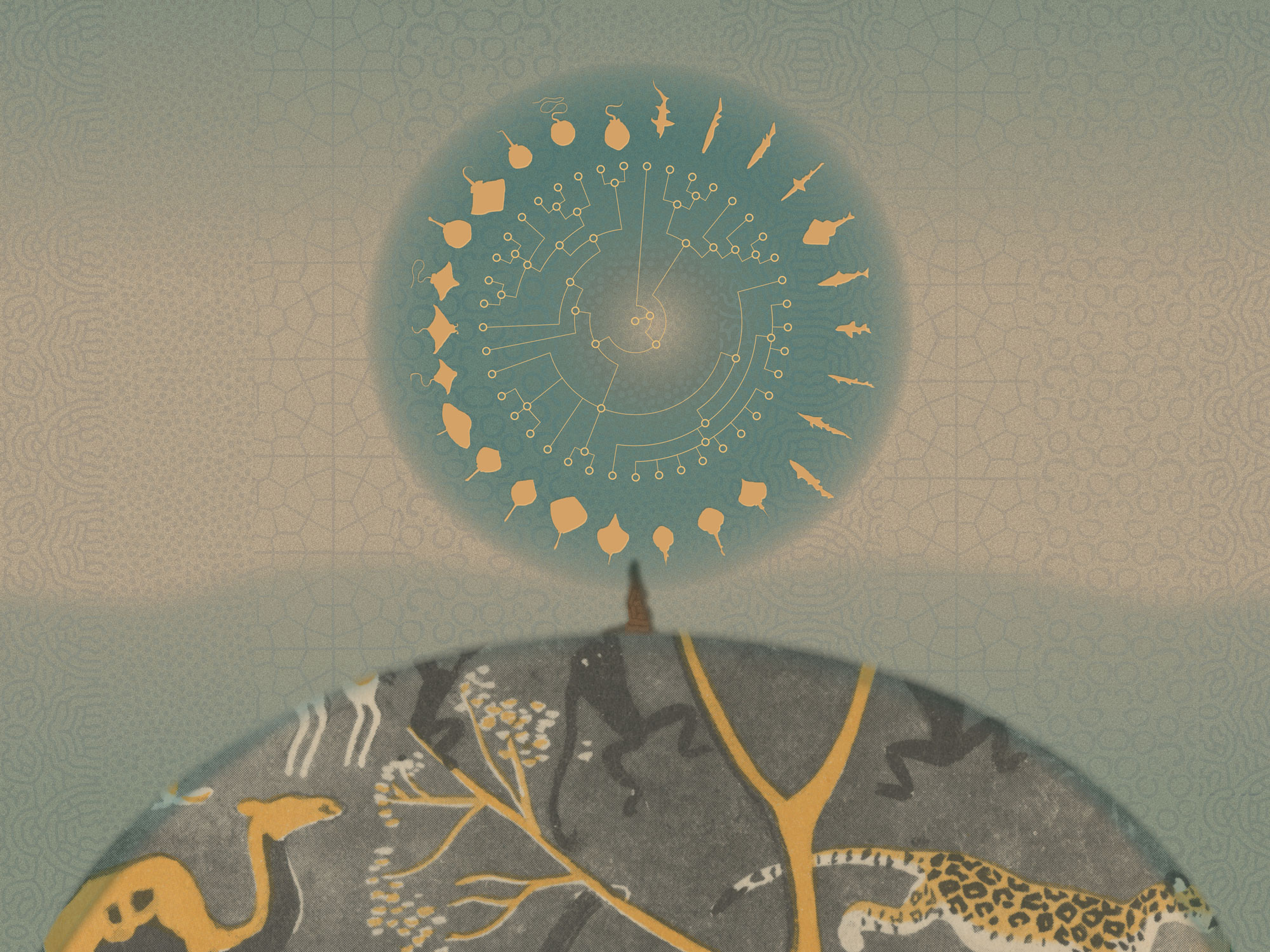As a child in the Rift Valley of Kenya, surrounded by creatures that are bedtime stories or stuffed animals for most children, Gavin Naylor had questions. Much like the Elephant’s Child in Rudyard Kipling’s “Just So Stories,” Naylor had an insatiable curiosity about the lions and wildebeests, zebras and giraffes around him.
For the Elephant’s Child, curiosity leads to a question too many when he asks a crocodile where he gets his dinner. The crocodile bites the baby elephant on the nose, and in the ensuing tug of war, voilà, the elephant gets his trunk. For Naylor, curiosity has led to three decades of research in evolutionary biology. The Elephant’s Child is spanked for his curiosity, and Naylor says he has run across a professor or two annoyed by his curiosity and need for answers to questions about life’s diversity.
“We know mutations are correlated with variation, but we don’t know the nuts and bolts,” says Naylor, the director of the University of Florida Program for Shark Research. “This has bothered me since I was a teenager. I would ask ‘How,’ and teachers would tell me ‘There are millions of mutations, Gavin, evolution just happens.’
“But how?
“We need more than Just So Stories and the notion that somehow you pull a rabbit out of a hat and something happens – the elephant gets its trunk,” Naylor says. “That is not very satisfying.
“I want the theory that makes evolution inevitable,” he says, “not unlikely.”
Primed by biodiversity for a life in science, Naylor got a Ph.D. in zoology and began his own research in molecular genetics and phylogenetics.
But as a scientist, it wasn’t the animals of the East African bush that caught his attention. For the fossil record he needed to tell an evolutionary story, he had to turn to a watery world: How did the hammerhead shark get its hammer? The sawfish its serrated snout? The ray its water wings?
Natural Fit
Naylor arrived at UF’s Florida Museum of Natural History in 2017 to direct the Florida Program for Shark Research and the International Shark Attack File, built up and made famous by Director Emeritus George Burgess.
A year after his arrival he still has a kid-in-the-candy-store demeanor about the resources available to him at UF. He has connected with computer scientists, statisticians, biochemists and others whose specialties he can tap into to develop his own work. In his previous positions, he found collaborators off campus to help with facets of his research. Those collaborations were fruitful, but time-consuming.
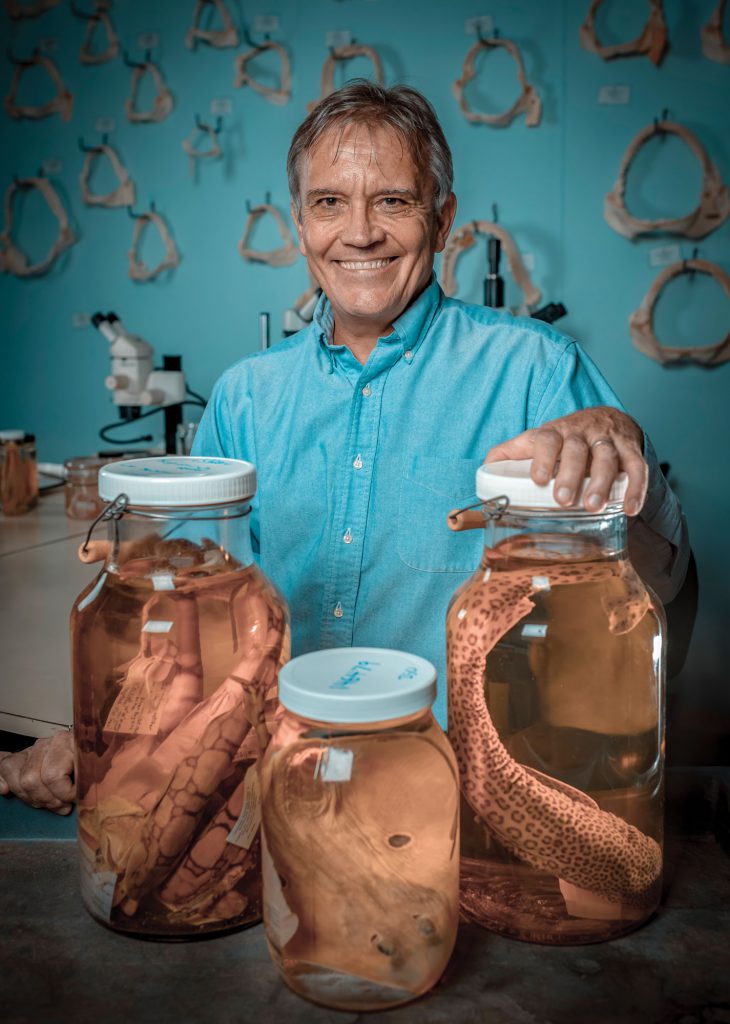
“Here, I can just go knock on somebody’s door and say ‘Hey, I’ve got this problem.’ Usually, they’re like, ‘Yeah, that’s easy.’ So, coming to a big research university, I can find people with unimaginable skills, and I can find them just down the corridor.”
By their nature, evolutionary questions are multidisciplinary, and he says that means he constantly bumps up against areas where, without collaborators, he would lack the expertise to forge ahead. He says he is fortunate that his colleagues at UF seem to be interested in the same evolutionary and biodiversity questions that drive him.
“I’m cursed by being interested in problems that I don’t have the skills to solve,” Naylor says. “But in this environment, there are people who will help.”
He understands the public’s fascination with the charismatic animals he studies but would like to see that thirst for knowledge last long after Discovery Channel’s hugely popular Shark Week, which runs every summer and sprinkles science in with sensational footage. He admits, almost reluctantly, that he has never seen an episode of Shark Week – “maybe I shouldn’t say that” – but a week of sharks would not satisfy his curiosity anyway.
Since his arrival, he has become acquainted with the huge popularity of UF’s shark attack file and is now the go-to source for help in identifying the shark in a shark-human interaction. In 2018, as of Oct. 1, there were 40 attacks listed in the shark attack file database, and Naylor says documenting the attacks involves about 200 variables, from the temperature of the water to the spacing of the teeth in a wound.
One encounter yielded an opportunity for more than an educated guess. After attacks in the summer off Fire Island, New York, Naylor was asked to help identify the species. The shark left behind a rare clue – a tooth fragment – so he was glad to help. Postdocs in his lab sequenced the mitochondrial genome and identified the attacker as a sand tiger shark, likely following a school of fish, and not the great white shark the community had feared. The ID yielded a short item in the journal Nature.
“I don’t know why it is better to be eaten by one species than another,” Naylor says. “But it seemed to calm them down.”
Naylor says the shark attack files are an important avenue for outreach, extending even to his work in evolutionary biology.
“If I can lure people in with a shark attack files carrot and they leave out the exit door being interested in evolutionary biology,” Naylor says, “that’s great.”
Evolutionary Detour
Naylor stumbled into the world of chondrichthyans – sharks, skates and rays – in graduate school. To examine the evolutionary questions he had in mind, he knew he needed a living creature with a long fossil record. Mammals are well studied, Kipling’s explanations for how the leopard got its spots or the elephant its trunk or the camel its hump notwithstanding. Naylor’s adviser suggested snails, but snails were taken; someone already deep into snail evolution.
“So he said, ‘What about sharks? They have a huge fossil record and we don’t know how the hell to interpret it. See if anyone is doing sharks,’” Naylor recalls.
“Nobody was doing sharks,” Naylor says, “so that’s what I did.”
About 425 million years ago, sharks, skates and rays took a detour on the tree of life, branching off on their own. The branch they left behind gave rise to bony fishes, amphibians, snakes, birds and mammals, 64,000 or more species. The chondrichthyan branch, however, evolved independently and gave rise to just 1,200 species.
But the chondrichthyan branch has been resilient.
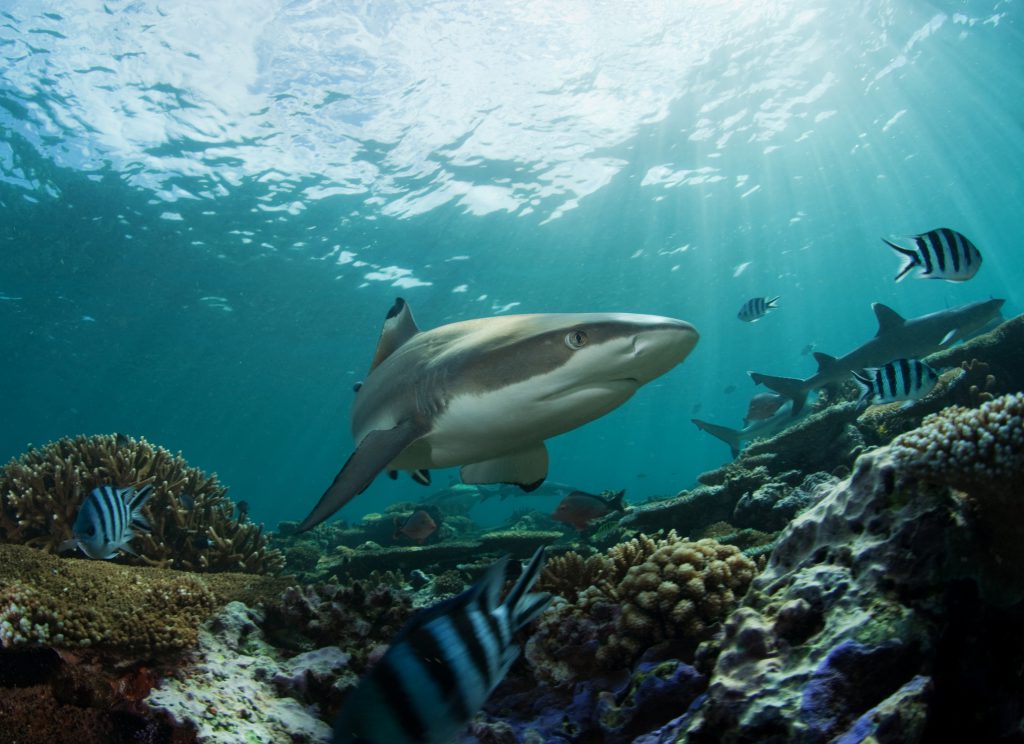
About 250 million years ago, more than half the planet’s living creatures died out along with 90 to 96 percent of the planet’s marine species in the Permian extinction. About 60 million years ago, the Cretaceous extinction wiped out non-avian dinosaurs. Sharks, skates and rays survived both, and that makes Naylor think they have a few tricks up their sleeve.
One of those tricks may be epigenetic regulation, turning genes on or off quickly, so they can adapt without a need for evolution.
“When they go to cold temperatures, a suite of genes switches on. They don’t have to wait until the genome responds,” Naylor says. “If they can put on an overcoat when it gets cold, and their bikini when it gets warm, then they’re equipped to deal with a changing environment.”
Diversity is a strong suit, too.
While most people know the great white shark, the star of “Jaws,” no one has made a movie about the lantern shark, which can glow in the dark and use camouflage. By controlling how much light it emits, it creates a cloaking device that makes it invisible to anything swimming above it or below it.
“The only time you can really see them is from the side, and if you see them from the side, it’s probably too late,” Naylor says.
Others, like the Greenland shark, are estimated to live 400 years.
“There are probably Greenland sharks swimming around that were alive at the time of George Washington,” Naylor says.
Sharks’ reproductive methods are as diverse as the rest of vertebrates combined, Naylor says. Some lay eggs that hatch outside the body, others lay eggs that hatch inside the body. Some have a placental connection to the mother. The sand tiger shark nourishes its developing young by letting the siblings fight it out in utero. As eggs hatch and develop, the tiny sharks swim around the uterus attacking each other. It’s a winner-take-all strategy, with each of the sand tiger’s uteri producing one offspring.
Some sharks, like bonnetheads, can use cloning – or parthenogenesis – to reproduce when a mate is not available. Scientists speculate that when mates show up, they return to reproducing sexually. Some great white sharks roam the ocean but, like sea turtles, return to a specific location to breed and give birth. And great whites are as different from blacktips as humans are from dogs, Naylor says.
There are sharks that can solve cognition problems that some mammals cannot solve and some that can recognize shapes, an ability they share with small children.
“Sharks are smarter than people might have thought,” Naylor says. “They’re not just the eating machines they were believed to be in the ‘60s and ‘70s.”
Diversity
Today, about 8.7 million species of eukaryotes inhabit the Earth. This doesn’t count bacteria or thousands of extinct species that have already disappeared and taken their evolutionary secrets with them. The diversity is tantalizing, Naylor says: blue whales, redwood trees, shrimps, spiders, starfish.
“We are lucky organisms to have been born as human beings and to see the amazingness all around us,” Naylor says. “How can you not be completely dazzled by the life we see around us?
“If all of this diversity arises from a single source, then obviously, acquiring novel traits must be something that is fairly easy to do,” Naylor says.
And if it is easy, Naylor reasons, there must be a mechanism at work. The likelihood that evolutionary diversity is random, as in the infinite monkey theorem – give enough monkeys typewriters and eventually, randomly, they will generate the works of Shakespeare – is deeply unsatisfying, he says.
“How did the hammerhead acquire its hammer from ancestors that didn’t have these hammers? There has to be something that is intrinsic that predisposes an organism to diversify and acquire traits. What is it?”
Growing up in the Rift Valley of East Africa, Naylor was struck by the variety of cichlids, which have evolved in the last 20,000 years into thousands of species. By contrast, the coelacanth has not changed in tens of millions of years, Naylor says. Why has one creature shown spectacular speciation and the other barely any speciation at all?
Ideally, he would compare the genome of the creature with a trait to its immediate ancestor without the trait, but with a creature that has a 425-million-year history, he would need a time machine. The next best thing, Naylor says, is an evolutionary tree to organize and interpret patterns and the order of transformations. If one animal has scales and another has hair, the clues to the scale-to-hair transition lie in between the two animals on the tree of life.
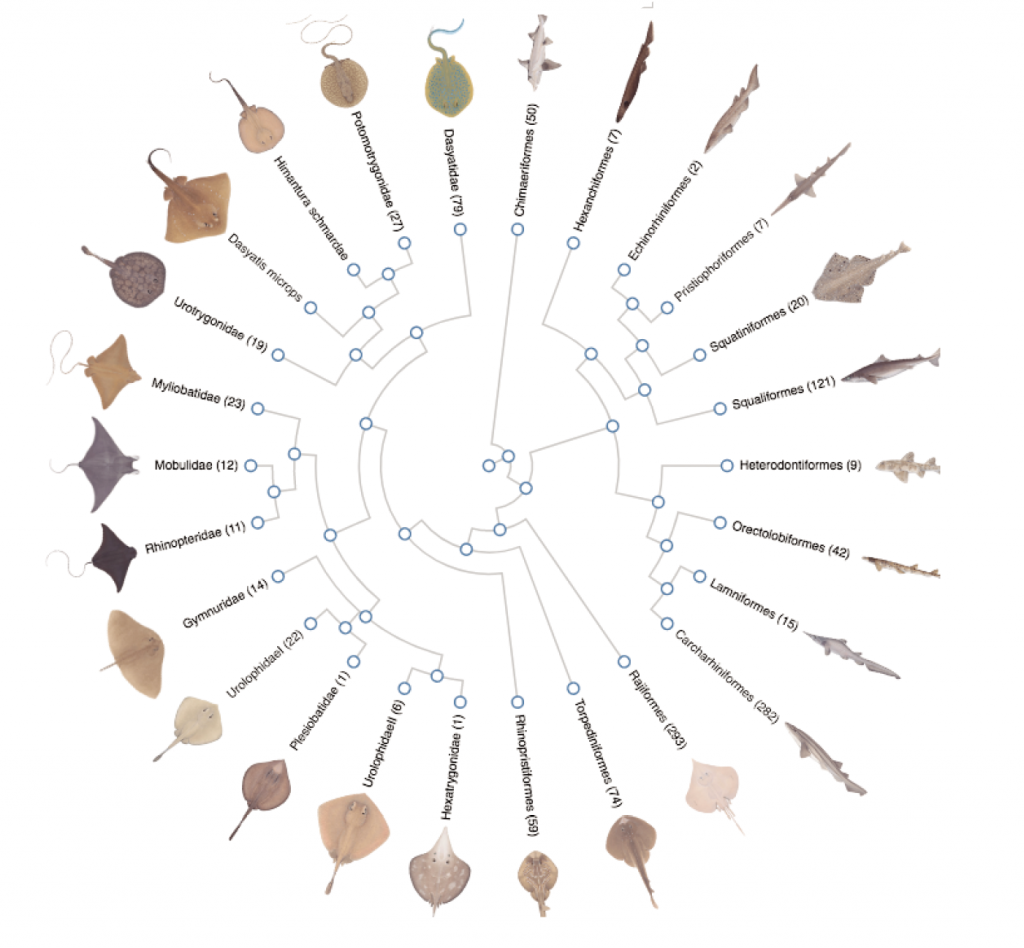
But first, you need a tree of life.
With National Science Foundation funding, Naylor compared the same gene across all chondrichthyan species and assembled a tree of life for sharks, rays and skates. The latest version is just about ready to go up on his website https://sharksrays.org, but when he revealed an early version at a conference in 2014, one member of the audience tweeted: “Shark Porn!!” Another tweeted that Naylor’s online database of chondrichthyans made other databases look like an abacus.
Naylor’s lab created the tree of life by using DNA sequencing data matched to fossils to reconstruct the patterns and timeline for diversification of chondrichthyans.
“People say sharks haven’t changed in millions of years, but they’ve changed a lot,” Naylor says. “On the outside they look like a torpedo that goes really fast in the water. Inside, they’re very different.”
Darwin, too, was interested in the origin of the variation he saw in nature and theorized about underlying factors that generated variation, but without the benefit of modern genomics. Even modern DNA sequencing, however, doesn’t explain all the variation in nature. Naylor refers to the variation as sprouting, and he says spatially coherent, highly organized structures seem to sprout out of nowhere in the course of evolution.
The mechanism that underlies this evolutionary novelty is what drives him. He has a hunch shared by many that the answers may lie in the decades-old work of computer science pioneer Alan Turing.
Patterns and Mutations
Mutations, Naylor says, perturb a biological system and that perturbation gets translated into variation in a way that doesn’t work in nonbiological systems.
“If you’ve got a toaster and you take some element out or you drop a fork in, the toaster doesn’t change into a vacuum cleaner, it changes into a broken toaster,” Naylor says. “But there’s something about life’s architecture that when you kick it or flick something into it, perturb it in some way, it embraces the perturbation and turns it into something with a physical variant. We want to know what that mechanism is.”
Naylor thinks these variations that some view as accidents have underlying algorithms. And that’s where Turing comes in.
Turing was a mathematician famous for inventing a machine during World War II that broke “unbreakable” German codes. His work laid the foundation for computer science, but Naylor found lesser-known and largely ignored work by Turing more interesting.
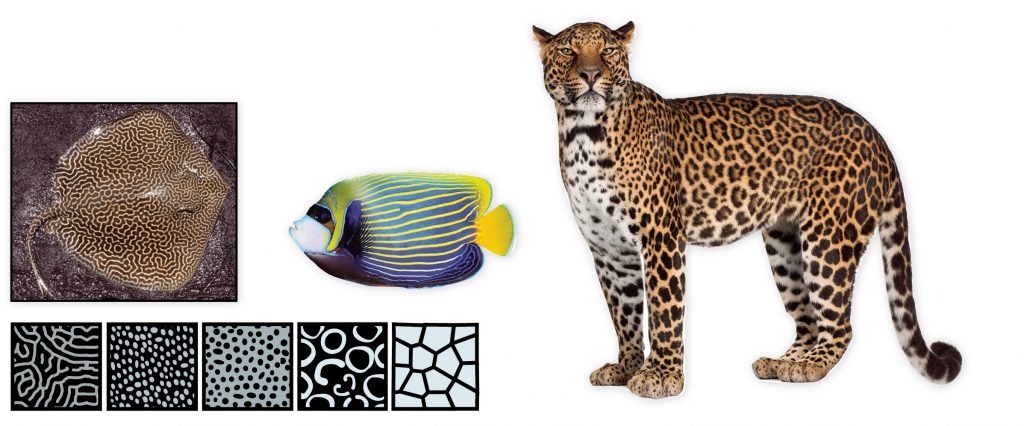
Instead of the infinite monkey theorem – random evolutionary success – there is the precision of math and chemistry at work in evolutionary novelty, he believes.
In 1952, Turing theorized that patterns in nature – the zebra’s stripes, the whorls of a shell – could be explained by chemical reactions between molecules. In his theory, a system of reactants generates spatial patterns that diffuse and then generate their own inhibitor to stop the process, creating a self-organizing pattern. By tweaking the inputs to this reaction-diffusion equation, the patterns change.
So, the spots on an animal or the patterns on a shell that might seem to be random actually have a mathematical foundation. Naylor points to the spotted diversity of the freshwater stingrays of South America – “this is one of my animals” – as an example of Turing models in action.
Recent work by colleagues suggests a minor change in the parameters of a reaction-diffusion equation can also explain morphological variation – the vertebrate fin-to-limb transition. The equation predicts the gene expression that is observed in a shark fin and a mouse limb.
“This excites me because it reconciles my 12-year-old curiosity about how this stuff arises. These guys explain the fin-to-limb transition,” Naylor says.
So, the next question: Where do fins come from?
“So, we can go from these Just So Stories to these reaction-diffusion models based on Turing’s ideas,” Naylor says. “We think that these self-assembly ideas can explain morphological sprouting.
“With these models, we’ve got organization coming out of chaos. There is nothing random about it.”
Survival of the Fittest
If sharks lived on a planet without humans to overfish them, Naylor would laugh at people who suggest they might be harmed by climate change, with its warming seas. The apex predators are apex survivors, not the lucky winners of an evolutionary lottery.
“I’m not worried in the least that these creatures will go extinct from climate change,” Naylor says. “They’ve weathered two mass extinction events. They are capable of adjusting.”
Although he was born in East Africa and grew up surrounded by peculiar, basically Pleistocene animals, he once said if someone gave him a submarine he would spend all his time looking around under water, exploring the biodiversity of the ocean.
“As an elementary school child, I was fascinated with Just So Stories – how the elephant got its trunk, how the leopard got its spots – and it’s somewhat ironic that as a practicing scientist I’m still interested in those exact same questions. I’d like to know how all these organisms acquire the features they have,” Naylor says.
“I think we can move beyond these magical, beautifully written stories by Rudyard Kipling that inspired many of us as children to a mechanistic understanding of how these features have evolved from cell biology.”
It’s a real-world evolutionary story, full of wonder nevertheless. Just so.
Source:
- Gavin Naylor, Director, Florida Program for Shark Research
Related websites:
This article was originally featured in the Fall 2018 issue of Explore Magazine.

